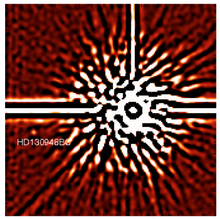Research
The scientific activity of the group is organized around several topics in the area of star and planet formation, which involves both an observational approach supported by the development of innovative instrumentation.
The structure and evolution of protoplanetary disks, the star/disk and planet/disk interactions, the interplay of the central young star with its circumstellar environment, as well as the conditions for the formation of protoplanets drive our interests. We look at young stars in the low-mass to high-mass regime and employ a variety of high-resolution techniques such as interferometry and direct imaging to probe the physics of these objects from the optical to mid-infrared regime. We are also interested in the characterization of sub-stellar objects (brown dwarfs) and ultimately exoplanets. In this context, the GRAVITY Young Stellar Objects Survey has been one of the most recent collaborative effort to study the innermost regions of circumstellar disks. Finally, close binary stars are surveyed to constrain dynamical masses and the processes of star formation, possibly in different environmental conditions characterized by sub-solar (Magellanic clouds), solar (Galactic clusters) and super-solar (Galactic Center) metallicity.
To support our science objectives, our group is engaged in an active instrumentation program that focuses primarily on novel ground-based instrumentation for the Very Large Telescope Interferometer (VLTI) at Paranal and for the future Extremly Large Telescope (ELT) on Cerro Armazones.
The GRAVITY Young Stellar Object Survey
The GRAVITY instrument is the near-infrared (K-band) second -generation VLTI beam combiner assisted by efficient fringe-tracking. The high-spectral resolution mode (R~5000 at 2 um) allows to measure differential interferometric quantities between the gas and the dust spatial distribution. A large team of scientists that have contributed to develop GRAVITY have conducted the systematic and homogeneous observation of a large number of T Tauri, Herbig AeBe and High-mass YSOs at milliarcsecond resolution to improve our understanding of the innermost regions of YSOs disks. Our group has directly contributed to the outcome of the survey.
-
The GRAVITY young stellar object survey: III. The dusty disk of RY Lup
-
A measure of the size of the magnetospheric accretion region in TW Hydrae
-
The GRAVITY young stellar object survey: IV. The CO overtone emission in 51 Oph at sub-au scales
-
The GRAVITY young stellar object survey: V. The orbit of the T Tauri binary star WW Cha
-
The GRAVITY young stellar object survey: VII. The inner dusty disks of T Tauri stars
Carbonaceous species and outflows in YSO
The carbon content in the protoplanetary disk around young star influences the composition of the atmosphere of the forming exoplanets. Small carbonaceous grains such as polycyclic aromatic hydrocarbons also play a role in the heating and hence disk structure, then influencing their subsequent evolution. Furthermore, tracing large-scale outflows allows to explore the star-disk interaction mechanisms.
Structured inner disk regions
With the advent of optical interferometers delivering sub-milliarcsecond resolution, the radial structure of protoplanetary disks can be discontinued in the dust and gas density distribution as various physical processes (e.g., formation and growth of planetesimals, photoevaporation...) will sculpt the disk that can then exhibit a complex spatial morphology. Aside few well-known examples, HD139614 was an early case of such an object that was found to harbor a gaped disk, as revealed by the combination of near- to mid-infrared interferometric observations combined with radiative transfer modeling.
-
HD 139614: the interferometric case for a group-Ib pre-transitional young disk
-
Inner disk clearing around the Herbig Ae star HD 139614: Evidence for a planet-induced gap?

Sub-stellar companions to main-sequence stars
Using adaptive optics or lucky imaging to compensate for the atmospheric turbulence, brown dwarfs companion to main sequence stars are detected and characterized using high-contrast post-processing techniques
-
High-contrast optical imaging of companions: the case of the brown dwarf binary HD 130948 BC
-
Lucky Imaging Adaptive Optics of the brown dwarf binary GJ569Bab
The growing field of astrophotonics
Astrophotonics is a unique interdisciplinary field that promotes the versatility of photonic based devices for astronomical instrumentation. Originally, it leveraged the telecom photonic development at 1.55 micron before expanding to other wavelength range. Photonic-based beam-combiner and spectrographs are the prime beneficiaries of the many light routing functionalities enabled by astrophotonics. Our group has developed a strong expertise in the development of interferometric PICs, which will benefit to the visitor instrument NOTT. Our research has been in part supported by the German DFG and the BMBF.
METIS: mid-infrared instrumentation for the ELT
Our group is actively engaged in the development and deployment of METIS: this is the mid-infrared imager and spectrograph for the Extremely Large Telescope. METIS operates in the mid-infrared wavelength range between 3 and 13 microns. More specifically, we develop in Cologne the Warm Calibration Unit, which is one the key sub-system of this first-light instrument.